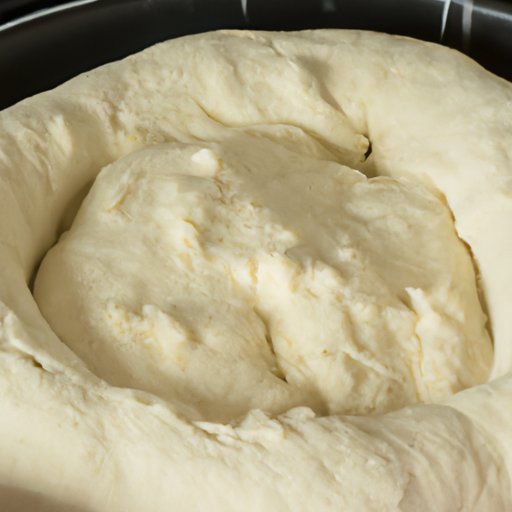Introduction
Making a great pizza is about more than just toppings. The quality of the dough can have a huge impact on the flavor and texture of your pizza. Making the perfect pizza dough requires time, patience, and practice. This article will provide an in-depth look at all the steps involved in making the best pizza dough.
Start with a Recipe
Before you start making your pizza dough, you need to find the right recipe. There are many different recipes available online, so it is important to find one that fits your needs and tastes. Look for recipes that include ingredients like flour, salt, yeast, sugar, oil, and water. Once you’ve found a recipe that looks good, read through the instructions carefully and make sure you understand each step.
When choosing a recipe, it is also important to consider the type of oven you will be using. If you are using a wood-fired oven, you may need to adjust the recipe slightly or use a different type of flour. You should also take into account the amount of time you have available for making the dough. Some recipes require several hours of rising time, while others can be made in just a few minutes.
Knead It
Once you have the ingredients and the recipe ready, it’s time to start kneading the dough. Kneading helps to develop the gluten in the flour, which makes the dough elastic and gives it a chewy texture. To knead the dough, start by pouring the ingredients into a large bowl and mixing them together with a wooden spoon. Once the ingredients are combined, turn the dough out onto a lightly floured surface and knead it with your hands until it is smooth and elastic.
It is important to knead the dough for the right amount of time. Over-kneading can lead to a tough texture, while under-kneading can result in a dense and crumbly texture. To ensure that the dough is properly kneaded, press two fingers into the surface of the dough. If the indentation springs back quickly, the dough is done. If the indentation remains, knead the dough for a few more minutes.
Rise Up
After the dough has been kneaded, it is time to let it rise. During this process, the yeast in the dough will produce carbon dioxide, which causes the dough to expand and become light and airy. To let the dough rise, place it in a greased bowl, cover it with a damp cloth, and leave it in a warm place for several hours. The time needed for the dough to rise will depend on the temperature of the room and the strength of the yeast.
The rising process is important because it affects the texture and flavor of the dough. If the dough rises too quickly, it will be dense and heavy. If it rises too slowly, it will be dry and tasteless. To ensure that the dough rises properly, check it every hour or so and make sure it doubles in size.
Temperature Matters
Temperature is another important factor when it comes to making the best pizza dough. When the dough is too cold, it won’t rise properly and will be difficult to work with. When the dough is too hot, it will rise too quickly and will be dense and heavy. To achieve the perfect temperature, keep the dough in a cool place and let it come to room temperature before you start working with it.
Get Creative
Once you have mastered the basics of making pizza dough, you can start to get creative. You can add herbs and spices to the dough to give it extra flavor, or you can add other ingredients like olives, sun-dried tomatoes, or cheese. Experimenting with different flavors and textures can help you create your own unique recipes.
Storing and Reheating
If you have leftover pizza dough, you can store it in the refrigerator for up to five days. To store the dough, wrap it tightly in plastic wrap and place it in an airtight container. When you are ready to use the dough, let it come to room temperature before rolling it out and baking it.
If you need to reheat pizza dough, preheat the oven to 350°F (175°C). Place the dough on a lightly greased baking sheet and bake it for 10 minutes, or until it is heated through. If the dough starts to brown too much, cover it with foil to prevent it from burning.
Troubleshooting
If you encounter any issues while making your pizza dough, don’t worry. Here are some tips to help you troubleshoot common problems:
- If the dough is too sticky, add more flour until it reaches the desired consistency.
- If the dough is too dry, add a few teaspoons of water until it reaches the desired consistency.
- If the dough doesn’t rise, check the expiration date on the yeast and make sure it hasn’t expired.
- If the dough is too dense, make sure you are kneading it for the correct amount of time.
Conclusion
Making the perfect pizza dough requires time, patience, and practice. Start by finding the right recipe, then knead the dough, let it rise, and pay close attention to the temperature. You can get creative with herbs, spices, and other ingredients to customize the flavor of your dough. Finally, remember to store and reheat the dough properly to keep it fresh and flavorful.
With the right recipe and a little bit of practice, anyone can make the perfect pizza dough.


